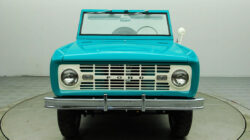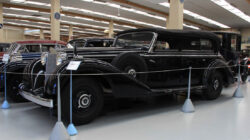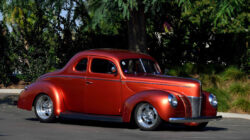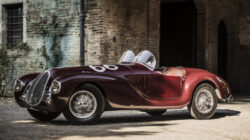For many automobile enthusiasts, the 1940 Cadillac Series 62 is the pinnacle of the American classic cars luxury and style. The sleek design, powerful V8 engine, and smooth-riding chassis of this classic make it one of the most sought-after models in today’s collector car market.
So if you want to get your hands on this American classic cars without paying an arm and a leg, read on for my review of the 1940 Cadillac Series 62 which includes pictures, specifications, and information about how much one can be worth today!
For someone looking to buy a car in 1940, the Cadillac was one of the most stylish options on the market that year.
It had roomy interiors and plenty of legroom, and you could customize it with all sorts of luxury features like air conditioning and an AM/FM radio.
The 1940 Cadillac Series 62 was sold at a base price of $1,950, while you could pay upwards of $2,800 to get an upgraded model. Today, these prices would be equivalent to more than $30,000 and $47,000 respectively.
Read also: 10 List Classic Cars from the 1940s: Classic and Timeless Design
Exclusive Features
The 1940 Cadillac Series 62 is an impressive vehicle on its own. However, with more than 100 high-quality features (including chrome plating) and unique extras (like a fully carpeted interior), it becomes truly one of a kind.
The driver’s seat comes with individual armrests for both passengers to keep them comfortable as you cruise along in your luxury car.
If you ever need to park or need help parking you can always use one of the 6×7-inch backlit plastic lens side view mirrors that will allow you to safely maneuver into even tight spots without bumping into anything.
Engine, Transmission, and Performance
1940 Cadillac Series 62 was fitted with a 389.7 cubic inch V8 engine that delivered 150 horsepower and 300 lb-ft of torque. The transmission was either a three-speed manual or an optional Hydra-Matic automatic.
Performance is about what you’d expect from a car of its class; it could achieve 0 to 60 mph in 20 seconds on its way to a top speed of 85 mph (though typical drivers were unlikely to take it up to that speed).
What’s more surprising is how well its brakes performed: The car could stop from 60 mph in just 115 feet, which is seriously impressive for its time.
Driver Controls
The series 62 was noted for having a particularly good set of features for drivers. The majority of them had what was called teletouch, which essentially allowed a driver to do just about everything from a single button on their dashboard.
There were three buttons on each side of their steering wheel that could be used to activate different features such as lights, windshield wipers, and more with just one push.
This not only made it easier for users to control these things while driving but also ensured they would be able to change them without taking their eyes off of the road or breaking their concentration in any way.
Fuel Economy
In 1940, vehicles averaged 8.7 liters of fuel per 100 kilometers; today that figure is 4.8 liters per 100 km. In its first year on sale in 1941, fuel consumption varied between 7 and 12 l/100 km (34 to 48 mpg-US; 30 to 57 mpg ‐imp ).
The V12 delivered a top speed of 135 km/h (84 mph) with fuel consumption of 10 l/100 km (23 mpg-US; 19 mpg ‐imp ).
Safety Ratings
The National Highway Traffic Safety Administration (NHTSA) provides information on how safe a vehicle is in its New Car Assessment Program (NCAP). The NHTSA crash-tests vehicles for frontal impact, side impact, and rollover.
Frontal crash ratings are determined by measuring occupant protection in a 35 MPH collision, while side-impact ratings look at how well airbags protect occupants in a 40 MPH side-impact collision.
Rollover ratings take into account dummy movement during a test that simulates an unintentional rollover. Here’s what to consider when looking at safety ratings for used cars.
Interior Style
1941 1942 Cadillac had four trims available; 4-door Town Sedan, 2-door Coach Sedan, 2-door Cabriolet, and the convertible Coupe de Ville.
The interior of these vehicles were some of their most impressive features. The all-new design featured a few major changes to what came before it.
They now featured self-leveling gas shocks for easier entry from all sides. The seat mounts were also improved to reduce vibration.
This new version also included ventilated armrests that also worked as a storage compartment for vanity or handkerchiefs.
Exterior Style
The general shape of a car’s exterior is based on a handful of factors. The number of wheels will tell you whether it’s a sedan or an SUV, where that air scoop is located determines whether it’s a front-engine car or rear-engine car; and so on.
Reviewing exterior style requires an understanding of what makes cars recognizable from just a few glances. If you look at a photo of your grandma’s Cadillac Series 62 (below), what do you notice first?
Do your eyes immediately lock onto her grill? Is it more obvious that her style is boxy rather than rounded?
Specification
The 1940 Cadillac Series 62 was a luxury car produced by General Motors from 1938 to 1939. It had a wheelbase of 126.0 in (3,200 mm) and it was 110.0 in (2,800 mm) wide. The car weighed 5,850 pounds (2,660 kg).
It came equipped with electric lights, power steering, vacuum power brakes with a booster, automatic clutch, self-starter, built-in windshield wipers, inside door locks, and outside keyhole-operated remote door locks for either front or rear doors.
Maintenance And Repairs
The Cadillac is in relatively good shape for a car of its age. The exterior styling remains on point even nearly 75 years after its original release.
However, as with all cars you’ll need to perform some regular maintenance and repairs over time. Most people will find they spend $500 – $1,000 per year on things like oil changes, brakes pads, shock absorbers/struts, etc.
Obviously, you may go more or less than that depending on your specific driving habits (the most expensive repair we can think of would be brake shoes) but that’s an average figure most people tend to stick to. If you have any further questions feel free to contact us!
Why Should You Buy a Cadillac 1940 Series 62?
When it comes to Cadillac, there’s no question that their cars are built with the top-notch quality you would expect from one of the oldest luxury car brands in the United States.
If you want to see just how premium Cadillac can be, then look no further than their 1940 Series 62, it features everything that makes Cadillac great with no skimping on quality or craftsmanship anywhere along the way.
These are just some of the many reasons why you should consider purchasing your very own 1940 Series 62.
What Makes this Car so Good?
Luxury cars have always been a symbol of luxury and class, and the 1940 Cadillac Series 62 Convertible is no exception.
The styling of pre-war Cadillacs are some of the most beautiful cars to ever hit U.S. roads, and with their massive wheel arches, large running boards, and wide bodies these coupes look every bit as good today as they did in 1939 when they were first introduced.
They are also one of only a few classic vehicles that can be reliably used on a daily basis without any worries about breakdowns or expensive maintenance costs that plague so many vintage rides. I wouldn’t hesitate to drive my car across the country!
What is so special about this car?
The Series 62 is a great car for all-around use, boasting impressive acceleration and top speed. The handling is also exceptional, making it easy to control on curvy roads or highways.
Additionally, its two-tone leather interior offers comfort for long trips and its six-cylinder engine gives you plenty of power.
It’s also exceptionally durable and reliable, no major repairs have been needed over time. If you’re looking for an all-around sedan that can take care of business with both power and luxury, look no further than the Cadillac 1940 Series 62!
Different Generations of the 1940 Cadillacs
The 1940 Caddies are easily distinguished from each other by their respective generations. The first generation features rectangular taillights and round headlights, whereas all subsequent generations feature a wrap-around grille and vertical headlamps.
Most valuable are first-generation coupes, which were sold with just one seat in the back, convertible and sedan models may command up to $8,000.
Sedans can also bring around $7,000, convertibles go for around $9,000, second-generation convertibles sell for around $3,500, and standard coupes can command anywhere from $3,500 to as much as $10,000 if they’re in great condition.
What is the Difference Between Each Model?
Buying a car is a daunting task for most people, and it’s even more confusing if you don’t know what you’re looking for. That said, different models of cars serve different purposes and cater to different needs.
The 1940 Cadillac series 62 convertible was designed as an open-air alternative to its competitors in an effort to maintain sales during wartime.
When luxury vehicles weren’t as popular as they usually are. With that in mind, here’s a closer look at some of its key features
Main Features of the 1940 Cadillac series 62
1940 Cadillac Series 62 is a very special classic car, so when we look into its engine details, it becomes apparent that there’s something out of ordinary with it. The classic General Motors Company V-8 Engine makes it a truly uncommon car.
It may seem somewhat out of place for an old-style car, but 40 Cadillacs are equipped with a very modern engine which at first was reserved only for some Cadillac Limited models and later became more popular and accessible to other customers.
They had been using these engines from 1935 up until 1942. In fact, some have even been called 1932 Cadillacs simply because of their powertrain design!
Cadillac’s 1940 Series: A Comparative Analysis
The Cadillac series of automobiles were named in two different ways, depending on the year produced. In 1938 and 1939 the series was named by its engine size.
In 1940 and 1941 it was named by its body style (i.e., Sedan). Starting in 1942, the series was numbered sequentially by year (Sedan = Series 62).
From 1955 to 1958 the Sedan de Ville was called the Series 62. Starting in 1959, Cadillac returned to an identification system similar to that used from 1938-1941; the current series is known as the Series 6T.
Cadillac Fleetwood
The Cadillac Fleetwood is a long-wheelbase, full-size car made by Cadillac. It was introduced in December 1937 as part of General Motors’ E-Body cars.
The Fleetwood used every major body variation built by Cadillac during its first 50 years of production and its final model year was 1979. Except for minor trim variations, all coupes and sedans were called Fleetwoods.
All convertibles were Sevilles or Eldorados, although some upmarket models from those series became Fleetwoods after 1970 when the De Ville convertible model name was discontinued.
A limousine model (Fleetwood Limousine) appeared early in 1941 on a 144-inch wheelbase, along with ambulances and hearses that continued into late 1971.
Cadillac Sixty Special
Created specifically for women, and often referred to as Cadillac’s ladies model, Cadillac Sixty Special was based on Cadillac Series 62 but featured a shorter wheelbase.
Only 659 of these were built in 1939 and only 204 in 1940 (likely due to low demand). However, with a starting price of $1,825 (equal to $ today), it was one of Cadillac’s cheapest models on offer.
It offered most features available in other models at that time. However, it lacked power windows and door locks, those had to be manually installed by a car dealer or mechanic before being purchased by an owner.
Cadillac Seventy-Two Touring Sedan
Built between 1939 and 1941, Cadillac Seventy-Two Touring Sedans came with a powertrain consisting of a 217.7 cubic inch I8 engine capable of producing 120 HP with 135 foot-pounds of torque.
This engine was paired to a 3-speed synchromesh transmission with a semi-floating rear axle and solid front axle construction.
The top speed was approximately 75 MPH on flat ground and 60 MPH in reverse, depending on weather conditions and load.
Also standard were four-wheel vacuum-operated drum brakes powered by either 16 or 19-gallon gas tanks.
Cadillac Sixty-Special V16
The Cadillac Sixty-Special V16 was a line of vehicles built by the Cadillac between 1936 and 1947. Initially an upper trim series for sedans and coupes, it later became a subseries for limousines and formal convertibles.
It also served as a trim package for standard-bodied cars. The Special was advertised to be exclusive and often featured more luxurious trim than even higher-trim Cadillacs, especially in its later years as a limousine/convertible subseries.
How Many People Can Fit in This Vehicle?
The 1940 Cadillac Series 62 Convertible seats two adults in front and one person in the back. If you have very tall friends, I don’t think they would fit comfortably, but it should accommodate most people.
The rear seat is basically a bench seat. It looks similar to a typical bench you might find on an airplane, except that it folds forward so that you can lay it flat to create extra cargo space.
So, if your luggage needs some extra room when packing for your road trip, it may be worth checking out how many suitcases will fit in your 1940 Cadillac!
What About Maintenance Cost and Value?
1940 Cadillacs in good condition usually sell for $25,000 to $45,000. Given that most of these vehicles have been driven regularly for over 70 years and have required various repairs along the way.
Owners should expect to spend another $5,000 or so on maintenance (and possibly more if structural work is needed).
Because there are few 1940s Cadillacs in good condition left, their value is sure to keep rising. So owners shouldn’t be afraid of driving them often, as long as they can afford it.
Things You Need to Know Before Buying a Classic Car
When you buy any type of classic car, it’s always worth doing your research. There are certain things to look out for and consider before making that purchase.
Before you go out and buy that Cadillac 1940 Series 62 – or any other classic car for that matter – there are many things to consider. Some of them are obvious, but others could be easily overlooked.
For example, when buying an old car in general it’s best to learn about its previous owners and make sure they were all good drivers who took care of their vehicles over time.
Conclusion
The 1940 Cadillac series 62 is one of a kind. You’ll notice from its beautifully hand-formed bodywork that every detail was meticulously considered and executed, which makes it not only a piece of art but also an icon that we’re happy to have in our car collection.
Few cars are as timeless as it. If you see one on the road today, you’ll notice that most people just smile and give a nod of respect; many might even turn their heads for another look!
So if you’re looking for a car with style and charisma to spare, search no further than the 1940 Cadillac series 62. We think you’ll find it more than meets your expectations.






